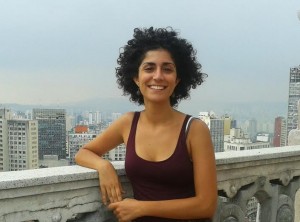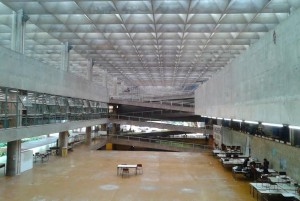OUT OF THE BOOT – Raffaella, Hanukkah Miracle in Sao Paulo
 By Simone Somekh and Shirly Piperno
By Simone Somekh and Shirly Piperno
The Jewish holiday of Yom Kippur was fast approaching, yet Raffaella Toscano, 26, had just arrived in Brazil for a four-month student partnership with the University of Sao Paulo. From the moment she landed in this spectacular South American country, Raffaella had been incredibly busy searching for a suitable apartment and starting her ambitious project, yet she was keen to celebrate the holiest day of the Jewish calendar with the local community. Yom Kippur is not only a day of personal spiritual connection, where she would fast and meditate on the past, the present and future, but also an opportunity to connect with other Jews as a whole.
Raffaella, an architecture student from Rome, had been in Sao Paulo only once before for a two-week workshop at a local university. She didn’t know any Jew living in the city. However, she sent a few emails to her Italian friends from Hashomer Hatzair, the Jewish youth movement she had been part of back in Rome; as she knew some of them had met a few Brazilian Jews during their gap year program in Israel. That night she arranged to meet one of those “friends-of-friends”, whose girlfriend immediately invited Raffaella to her house for the traditional Yom Kippur Eve dinner.
 “I may come from a European capital, but Sao Paulo is a huge city. At first, I felt a little bewildered,” stated Raffaella, who won a scholarship to write her graduate thesis in Brazil after completing her architecture studies at La Sapienza University in Rome. “I chose this major because I believe that architects can truly actively contribute to society.” Passionate about social architecture (“I’m not the type who’d design airports and skyscrapers, you know”), Raffaella spent her months in Sao Paulo working on a municipal project in the prestigious faculty of architecture of the University of Sao Paulo. The school was designed by the famous Brazilian architect Vilanova Artigas, she stressed. “You should really Google it, it’s beautiful,” she told me.
“I may come from a European capital, but Sao Paulo is a huge city. At first, I felt a little bewildered,” stated Raffaella, who won a scholarship to write her graduate thesis in Brazil after completing her architecture studies at La Sapienza University in Rome. “I chose this major because I believe that architects can truly actively contribute to society.” Passionate about social architecture (“I’m not the type who’d design airports and skyscrapers, you know”), Raffaella spent her months in Sao Paulo working on a municipal project in the prestigious faculty of architecture of the University of Sao Paulo. The school was designed by the famous Brazilian architect Vilanova Artigas, she stressed. “You should really Google it, it’s beautiful,” she told me.
The project Raffaella was involved in is called “Hidroanel Metropolitano” and aims at transforming the main rivers of the city into waterways and their margins into main metropolitan public spaces.
“You see,” said the young architect. “As for now, the rivers are an obstacle to the city. They are dirty and downgraded.” Raffaella explained that this issue involves most public areas of the city, which are almost never crowded, due to the high crime rate. “People are scared to walk around the streets, so they move around the city in their cars and mainly hang out in malls. However, I believe it ends up being a vicious circle: the more the inhabitants don’t walk around public spaces, the more the public spaces will be downgraded.”
Nevertheless, Raffaella points out that the situation is changing as the locals are taking the matter to heart and re-appropriating themselves of the neglected public spaces. To do so they are not only using architecture and design, creating temporary installations and recreational spaces, but also organizing festivals celebrating music, theatre, and dance. Thanks to this new awareness the once empty piazzas are slowly starting to gain popularity and therefore becoming less dangerous. In addition these kind of events bring the locals together and liven up the city, making foreigners like Raffaella feel welcome and involved in the Brazilian’s ways and flair.
The first night of Hanukkah, Raffaella left the university and returned home. She knew the festival of lights would begin that night, but had no plans and was not aware of any Jewish congregation in the area where she lived. She searched online for an event and found one in a synagogue nearby. As she approached the building, a security guard asked her a few questions. ‘What’s the name of the Rabbi?’. She had no clue. “For security reasons, they couldn’t let me in if I didn’t know the name of the Rabbi.” Very disappointed, she walked back home thinking of ways she could build her own menorah; then, she bumped into three young Orthodox Jews, likely to be Chabad.
“’Chag Sameach’, I told them.”
Not only the wished her ‘Chag Sameach’, Happy Holiday, back, but they also gave her a menorah and a sufganiyah, the traditional jelly donut Jews eat on Hanukkah. Raffaella went home and lit the menorah with her roommates.
“It was a Hanukkah miracle!” she said, still excited as she recalled the event that strangely happened on one of the days we commemorate the miracle of the Menorah burning for eight nights and days during the times of Judah the Maccabee.
Raffaella is now back in Rome, where she plans on graduating in the upcoming months. Italy is her home country, but abroad she experienced a very different approach to the academic studies she has been previously accustomed to. “Here [in Italy] interns are not paid. Youngsters cannot easily be both students and workers. In Brazil, instead, universities are used as platforms to enhance society. I’d never seen anything like that before and I loved it.”
*Simone Somekh is a student at Bar-Ilan University, Israel, and works as a freelance writer. Shirly Piperno is a fashion styling and communication student at Istituto Marangoni, London.
